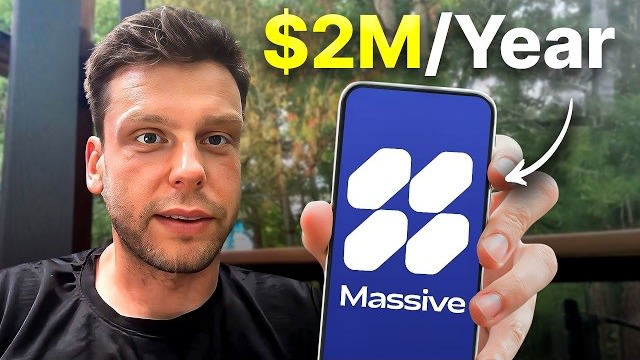Consumer apps hitting $2 million in annual recurring revenue aren't exactly common. Ask around, and I think you'll find that several app founders struggle to break six figures, let alone scale to millions. But Dan, the founder of Massive (an AI-powered job application tool) cracked the code using some unconventional tactics that I hadn't thought of before.
In today's podcast interview recap, we'll cover his playbook and it break it down. I'd wager that Dan has run more marketing experiments than most founders attempt in their entire lifetime, and he's not shy about sharing what actually moves the needle versus what ends up being noise.
From pivot to viral LinkedIn post
The origin story here is an entertaining one. Dan had raised $3 million for a previous product that didn't work out, and during the pivot discussions his engineer casually suggested, "You should use GPT to fill out job applications." Dan initially hated the idea.
But, he decided to test it anyway with a simple LinkedIn post. At the time, he had maybe 500 connections. The post exploded: 8 million impressions, 5,000 comments, and people going crazy for the concept. That single post validated the entire business model before they wrote a line of code.
Here's the thing about that post: Dan almost did it out of spite. He was trying to prove his engineer wrong, expecting maybe two likes. Instead, he stumbled onto something that people desperately wanted.
It's certainly cliché, but sometimes the best ideas come from the places you least expect.
The reality check: wait lists don't work
After that viral moment, Dan spent two months building up a wait list of 40-50K signups. When they finally launched, reality hit hard. Only about half a percent of the wait list actually converted to paying customers.
That said, Dan's advice goes against the grain in terms of what we usually hear about wait lists:
"I think wait lists are useless. You don't need to bring people onto a wait list. Get people to pay. It's going to be harder, but it's going to give you more results."
His advice for anyone launching today? Skip the wait list entirely. Instead, spend $1-2K on a handful of influencers with a tight value proposition. Test with proven distribution channels first. Get people to actually pay for something, even if it's a smaller version of your product.
Scaling to $200K monthly revenue
Today, Massive pulls in about $200K per month with a tiny team: Dan, one full-time engineer, and a handful of VAs and ops people. They've processed over 10 million job applications. The secret?
A hard paywall from day one.
"As soon as we got the first subscription, I was like, 'This is going to be a billion dollar company.'" That confidence in charging for value from the start made all the difference.
Their current growth stack is straightforward: paid ads, UGC (user-generated content), and influencers. Whatever's working and showing arbitrage at the moment, that's where they double down. That's a common theme I've heard from several founders in these interviews.
The science of viral UGC
Dan's approach to UGC is systematic. He's learned that 80% of successful content comes from analyzing what's already gone viral and then taking it, and adapting it to your own app. On the other hand, only 20% should be net-new experimentation.
One example he showed me was a format they call "Career Dave style" (named after a competitor who consistently hits viral numbers with a specific discovery-based format). The hook involves two people in frame, with the camera moving naturally while someone "discovers" something about job applications. It feels organic, authentic, and (most importantly!) converts like crazy.
But here's the nuance: the same format can get 382 views or 1.7 million views depending on micro-expressions and authenticity. Dan showed me examples where creators spent weeks iterating on the same basic concept until they nailed the delivery that resonated.
"Most UGC creators look like garbage. They're trying different stuff instead of iterating on concepts that actually work. You've got to find what gets 6,000 views and keep pushing on that for weeks."
Audience targeting through content
One of Dan's most interesting insights was about audience targeting through content hooks. He discovered that videos starting with "Stop using LinkedIn to apply to jobs" convert incredibly well, while "Stop using Indeed to apply to jobs" gets views but terrible conversions.
The reason? LinkedIn targets white-collar professionals who are willing to pay for job automation. Indeed targets blue-collar workers who apply to three jobs, get four interviews, and they're set. Same format, completely different audience, totally different business outcomes.
"You're almost thinking about audience targeting except your targeting is calling out the characteristics of the audience in the first 3 seconds." It's like Facebook ad targeting, but for organic content.
The dark side: what not to do
Dan also called out some seriously shady practices happening in the space right now. Companies are creating fake success stories, hiring actors to pretend they landed jobs using their apps, and even stealing real users' job acceptance videos to repurpose as fake testimonials.
"It's going to end badly. The FTC is going to come for these companies just like they did with every gray hat and black hat ecom operation. They lost everything."
The lesson here is clear: build for the long term. Short-term tactics that mislead consumers will eventually catch up with you, and the damage to your reputation isn't worth any temporary growth.
Practical advice for early-stage founders
If you're starting with a limited budget (say, $10K), Dan's advice is refreshingly actionable:
Test with influencers first. Get proven distribution and validate your message before building.
Focus on problem-solution fit. Make sure your hook targets the right audience with the right problem.
Copy what works, then iterate. Don't reinvent the wheel. Adapt proven formats to your vertical.
Get people to pay early. Skip vanity metrics like wait list signups and focus on actual revenue.
Wrapping up
Dan's success with Massive isn't just about viral videos or clever marketing tactics. It's about understanding your market deeply, being willing to experiment relentlessly, and staying focused on solving a real problem for people who will actually pay for the solution.
"You've got to give a shit about what you're building. Give a shit about your users, and that will naturally translate into you figuring out how to tell more people about it."
That's the real secret behind the $2M ARR. Not growth hacks or viral tricks, but genuine conviction in solving a problem people care about, combined with the persistence to figure out how to reach them effectively. Dan's approach offers a clear roadmap: find product-market fit first, then figure out sustainable ways to tell people about it. The tactics might change, but the fundamentals remain the same.
As always, if you're ready to test your paywall, run price tests and more for your app, then you're already in the right spot. Sign up for a free Superwall account today!

